Recent Articles
-
GuatePhoto 2012 Call for Submissions
-
The Alphabet of Light, #5, by Kirsten Rian (Linda Connor)
-
Herd in Iceland: A film by Lindsay Blatt and Paul Taggart
-
Revisiting Photoville: Highlights from the Exhibitions
-
Photo Awards Results
Categories
- #SANDY
- 2016
- 27th International Festival of Photojournalism
- Aaron Vincent Ekraim
- Africa
- AIPAD
- Almond Garden
- American Photo
- Anna Beeke
- Aperture
- Art Desks
- Artist Events
- Artist talk
- Award
- Awards
- Barmaid
- Barney Kulok
- Behold
- Best of 2015
- Book Launch
- Book release party
- book signing
- Book signings
- Book-signing
- Bryan Schutmaat
- Call for applicants
- call for entries
- Cara Phillips
- CDS
- Chicago
- ClampArt
- Closing Exhibition
- Competition
- Conservation photography
- Contests
- Cowgirl
- Critical Mass
- Cyril Christo
- Daily Mail
- Daylight
- Daylight Books
- Daylight Digital
- Daylight Digital Feature
- Daylight Photo Awards
- Daylight Project Space
- dj spooky
- Documentary Photo
- DPA
- Dread and Dreams
- E. Brady Robinson
- Eirik Johnson
- Elaine Mayes
- Elinor Carucci
- Events
- Every Breath We Drew
- exhibit
- Exhibition
- Exhibitions
- Fall 2015 Pre-launch
- Festivals
- Film Screening
- Film screenings
- Fine Art
- Flanders Gallery
- Fotobook Festival Kassel
- Françoise Callier
- From Darkroom to Daylight
- Frontline Club
- Gabriela Maj
- Gays in the Military
- george lawson gallery
- GuatePhoto
- Guatephoto Festival
- Hariban Award
- Harvey Wang
- hochbaum
- Home Sweet Home
- Huffington Post
- Hurricane Sandy
- Interview
- J.T. Leonard
- J.W. Fisher
- Janet Mason
- Jess Dugan
- Jesse Burke
- John Arsenault
- Jon Cohen
- Jon Feinstein
- Katrin Koenning
- Kuala Lumpur Photo Awards
- Kwerfeldein
- L'Oeil de la Photographie
- LA
- Landmark
- Leica Gallery
- Lenscratch
- LensCulture
- Library Journal
- Lili Holzer-Glier
- Lori Vrba
- Lucas Blalock
- Malcolm Linton
- Marie Wilkinson
- Mariette Pathy Allen
- Michael Itkoff
- Month of Photography Los Angeles
- Mother
- Multimedia
- Nancy Davidson
- New York
- New York City
- News
- NYC
- ONWARD
- Opening
- Opportunities
- Ornithological Photographs
- Out
- Party
- Philadelphia
- Photo Book
- Photo Booth
- photo-book publishing
- PhotoAlliance
- Photobooks
- Photography
- Photography Festival
- photolucida
- Poland
- portal
- Pre-Launch
- Press
- Prize
- PSPF
- Public Program
- Raleigh
- Rayko Photo Center
- Recently
- Rencontres De Bamako
- Reviews
- Robert Shults
- Rockabye
- Rubi Lebovitch
- San Francisco Chronicle
- Seeing Things Apart
- SF Cameraworks
- silver screen
- Slate
- slideluck
- Sociological Record
- Soho House
- spring 15
- Spring 2016
- Stephen Daiter Gallery
- Sylvania
- Talk
- Tama Hochbaum
- The Guardian
- The Moth Wing Diaries
- The New Yorker
- The Photo Review
- The Solas Prize
- The Superlative Light
- The Telegraph
- TIME
- Timothy Briner
- Todd Forsgren
- Tomorrow Is A Long Time
- TransCuba
- Upcoming events
- USA Today
- VICE
- Vincent Cianni
- Visa Pour L'Image
- Vogue
- We Were Here
- Wild & Precious
- Wired
- Workshop
- Zalmai
- Zofia Rydet
News
GuatePhoto 2012 Call for Submissions
Posted by Daylight Books on
Since the recent uprising of photo interest in Guatemala, the GuatePhoto International Photography Festival was born to spread the awareness of local and international photographic talents. This year, the GuatePhoto Festival will be held at the Canton Exposicion where they will be exhibiting work in old warehouses, streets, bus stations and public spaces, from November 7th to the 25th.
There is an open call so you can get involved in this great photographic movement. The subject matter is free for the participant to decide and out of all the submissions there will be 15 finalists in which one will receive the winning prize. The winning recipient will receive a $3,000USD cash prize and an all expense paid trip to the inaugural of the GuatePhoto Festival. Don't wait too long, the deadline is August 31st 2012.
Information and Submissions:
The Alphabet of Light, #5, by Kirsten Rian (Linda Connor)
Posted by Daylight Books on
Salt Ponds, Peru, 2010, by Linda Connor
Negotiating Imagination
The very first photo exhibition I worked on was Linda Connor’s. I was 24 years old. And I had grand plans to become a photojournalist and change the world. I can’t remember the how or why, but I did something really wrong while preparing that exhibition. I broke some glass, or I dropped a print or something.
That was more than 20 years ago, and the first and only time I messed up quite like that, but what I remember more specifically is standing in front of Linda’s luminous images, saturated in warmth, these geographies I’d never seen. Stone, light, and fragmented space collectively harvesting metaphor.
She recently said to me, “Photographs allow us to retain a visual record of the past, and help us negotiate our everyday lives.”
This notion of negotiationis pivotal to reconciling the thrumming choices presenting us with every potential image, the decisions involved with composition and storytelling, mirroring, as Linda says, the spectacle of abundance ordinariness that accompany every hour of every day. We eventually get wrinkled and tired from dancing between shoulds and coulds after a few decades, to be sure; but photography’s value is in its ability to bridge past with present, to archive bits of memory and create an inventory of impressions we call a life.
Once every 100 years Venus negotiates its way across the sky in perfect alignment between the earth and the sky, and just last month the transit of Venus appeared as a black dot against the sun. I was fascinated with this story, thinking about how much depends on the contours of everything else around us, the interplay of negative and positive space, the lining up, straight or crookedly, of everything. Venus actually orbits between the earth and sun about every year and a half, but due to the angle tilt it passes either above or below the sun. Near misses except for once a century.
Photography writer, editor and curator extraordinaire, Alan Rapp, landed on the crux of photography’s challenge when he recently told me, “Photography is vacillating as to whether its humanist tradition can meaningfully coexist with the radical visual possibilities of the practice, or whether it is more effective in reassuring us who we are than presenting us with unfamiliar sight.”
I didn’t go outside with a telescope on the night of June 5 to witness for myself this once in a lifetime ballad of sky, but I knew it was happening, and like 17th century scientists knew, that this event measured something of significance, literally and otherwise.
Perhaps some of photography’s continued success through this surge of technology and influx of users rests in trust that if an image is authentic, it reveals a piece of the artist’s interior. Doesn’t matter the content, place in the world, level of pragmatism or technical prowess. Those are irregardless details without implication to the intangible untouchables of a self.
I didn’t meet Linda until a few years after that initial exhibition, and I was greeted with an outstretched-arms-hug, with gesture holding sincerity, much like her photographs.
“A life without images would be as paltry as a life without music or literature. Images allow us to remember and imagine,” she tells me. And while it feels obvious, it’s not. It startles me to realize we do need permission sometimes, or a lot of times, to hold onto our collective and individual histories. And more even yet, to imagine.
To see some of Linda’s images, visit http://www.hainesgallery.com/artists/Connor_Linda/Connor_01.html
Herd in Iceland: A film by Lindsay Blatt and Paul Taggart
Posted by Daylight Books on
Filmmakers Lindsay Blatt and Paul Taggart met seven years ago, when Blatt worked as a photo editor at a news agency, and Taggart was a photojournalist covering international news. For two years, they have been collaborating on a project, where they have travelled to Iceland to film a documentary on Icelandic horses, and the community which surrounds these pristine creatures.
The team has launched a Kickstarter project to cover post-production costs and festival entries. There are just two weeks left in their camapaign, so check it out. This compelling work certainly warrants a much wider audience.
Of the film, Blatt and Taggart write:
"Herd in Iceland began filming in the fall of 2010, when Lindsay and Paul traveled to Iceland to document thei Icelandic herders as they collected their horses across the island's remote terrain. During the summer months, the horses live a wild existence, grazing in the highlands and raising their young. Each fall, they are rounded up by local farmers and directed across the stunning landscape. This valued tradition is a social and cultural touchstone for both the farmers who own the horses and the city dwellers who travel to the countryside to participate.
"The horse holds a precious place in Icelandic culture, art and tradition; for over 1,000 years Icelandic law has prohibited the importation of horses onto the island. By telling the story of this annual journey, Herd in Iceland captures the symbolism behind the horses and the nation they represent."
Check out the trailer for Herd in Iceland and get a small glimpse of two years of stunning footage.
Have a look at these still photographs by Blatt and Taggart.

An Icelandic horse in the landscape near Þingeyrar Farm in Iceland on September 27, 2010. Photo by Lindsay Blatt.
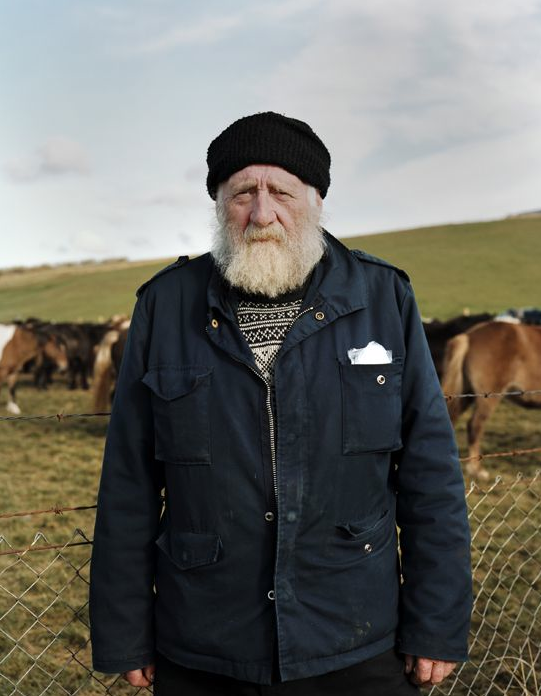
A retired fisherman at the Víðidalstungurétt round up in Iceland on October 2nd 2010. Photo by Lindsay Blatt.
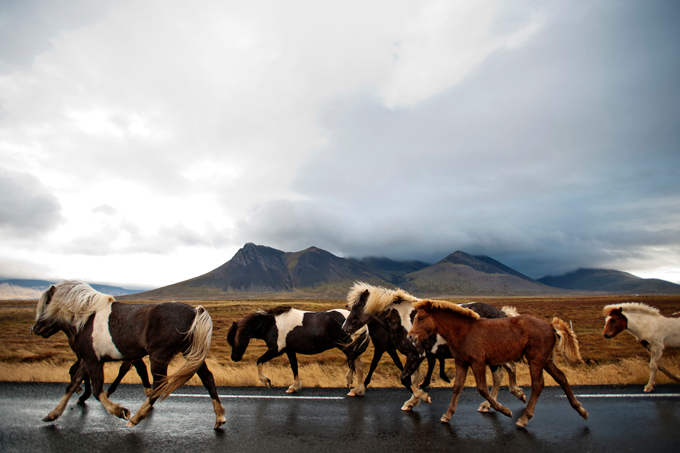
Icelandic horse walk down the higway to their farm after being sorted at the Víðidalstungurétt pen during the annual round-up on October 1st, 2011. Photo by Paul Taggart.

Kolbrun Yr Sturludottir helped to bring in the horses from Geitaskarð farm, on the way to the Skrapatungurétt round-up in northern Iceland on September 17, 2011. Photo by Lindsay Blatt.

One of the horses being herded through the lava fields near Landmannalaugar in southern Iceland on September 21, 2011. Photo by Lindsay Blatt.
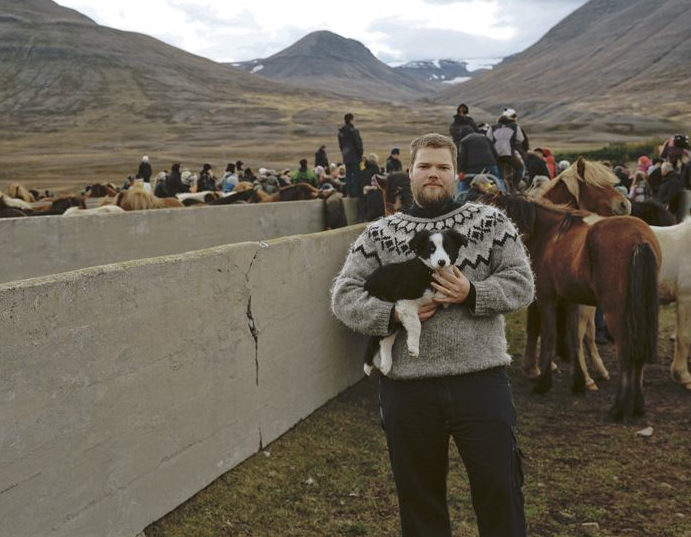
Davíð Logi Jónsson, with his border collie puppy in the sorting pen at Laufskálarétt in northern Icelandn on September 24th, 2011. Photo by Lindsay Blatt.
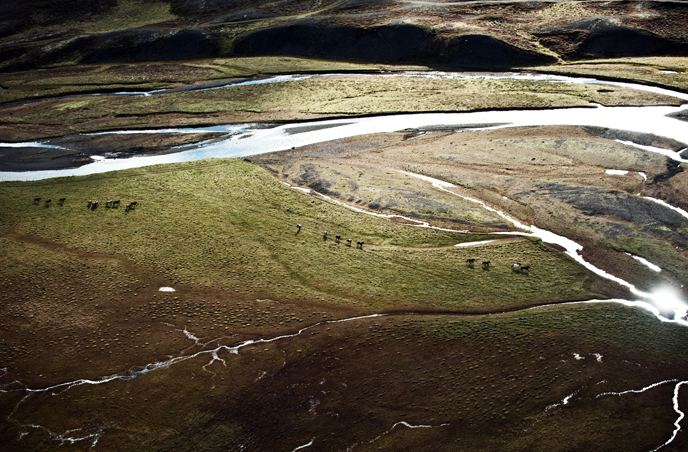
Icelandic horses run along a river leading to the Skrapatungurétt sorting pin in Iceland on September 23, 2010. Photo by Paul Taggart.
Be sure to visit the project's website to see more photographs from the Icelandic horse roundups, and to stay updated on the latest news on the film.
Revisiting Photoville: Highlights from the Exhibitions
Posted by Daylight Books on
Daylight's Photographs Not Taken Panel with Elinor Carucci and Ed Kashi
Over the past few weeks, a village of storage containers was converted into exhibition spaces for photographs. For the majority of the pop-up’s existence, the climate scorched even the most seasoned and durable documentarians, sweaty non-AC adept New Yorkers and their extremely loyal dogs. Indeed, during the last weekend, the majority of the visitors to Photoville took solace within the gigantic beer garden. In case you were one of the people who couldn't handle the heat long enough to take a good look at some of the images, here are some highlights.
As photographers are weathered by being knocked around in storage containers, attached to corroguated walls with magnets and exposed to extreme tempertures, photographs should too. We have Photoville to thank for bringing photographic prints out of a precious vein and into a strange, yet human environment. The exhibitions were, in all ways, steeped in documentary tradition.
The most compelling of containers featured images slapped on the walls, often missing clear links to authorship, such as Pete Brook’s Prison Photography on the Road, which conducts interviews with photographers documenting the criminal justice system, and was featured in Noorderlicht’s Cruel and Unusual two-container exhibition.
Of particular note in Noorderlicht’s exhibition was the work of Alyse Emdur. Her series, Prison Landscapes are as odd and humane as they are wonderful. Emdur documents backdrops painted by inmates in visiting rooms, which serve as makeshift portrait studios for inmates and their guests. Following the discovery of a photograph of herself as a young child visiting her brother in prison, Emdur began inviting inmates and their family members to send these portraits to her.

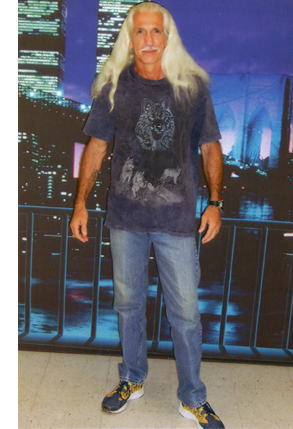
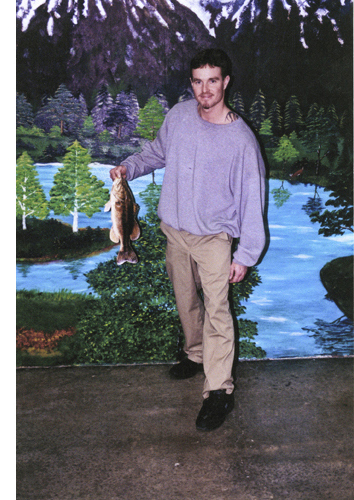
From Prison Landscapes, Alyse Emdur
Of the project, Emdur comments, “As inmates and their visitors pose for photos in front of these idealized landscapes they pretend, for a brief moment, that they are someplace else. The photographs are given to these visitors as gifts to take home and remember the faces of their loved ones while they are incarcerated. Created specifically for escape and self-representation, the idealized paintings of tropical beaches, fantastical waterfalls, mountain vistas, and cityscapes invite sitters to perform fantasies of freedom. Prison Landscapes offers viewers a rare opportunity to see Americas incarcerated population, not through the usual lens of criminality, but through the eyes of inmates loved ones.” In keeping with this mission, Emdur also displayed her own photographs of these backdrops made without human subjects. The violent colors of these painted vacation spots become nauseating flattened in the frame with the unveiled landscape of the rest of the visiting room.
Also included in Noorderlicht's exhibition were Lori Waselchuck's Grace Before Dying, recently the subject of a Daylight Multimedia feature, and For even more information about Noorderlicht's exhibition, including exciting documentation of demolition of all of Noorderlicht's exhibition prints following the conclusion of Photoville, visit prisonphotography.wordpress.com
Emily Kinni, as part of the 2012 Tierney Fellowship exhibition, also exhibited work within the prison photography genre. The photographs, the evidence of a major feat by any emerging photographer, chronicle now-defunct execution chambers in states where the death penalty has been outlawed. This work itself invokes morbid fascination by virtue of its subject matter, only Kinni’s project does so sans the direct use of the human subject. Instead, a sickly-positioned sign reading “Old Sparky” held in place with jumper cables above a well used electric chair invokes a portrait of just what compounds of human-kind would find themselves capable of hanging such a sign above the still displayed death-chamber artifact in “clever” gesture. One can only imagine the experience Kinni invoked for herself during her year-long fellowship.

Old Sparky, West Virginia Penitentiary, Copyright Emily Kinni
The Magnum Foundation also sponsored two well-received exhibitions, Bruce Gilden’s No Place Like Home: Foreclosures in America, which received a Magnum Foundation Emergency Fund Grant in 2010, and Sim Chi Yin’s China’s Rat Tribe. Sim Chi Yin was a Magnum Human Rights Fellow in 2010. Both series mark the launch of Magnum’s initiative to discuss the meaning and value of home, home as a space in flux. Each exhibitions occupied the space of the containers as a means to enhance the content in the exhibitions. Sim Chi Yin’s work on cramped spaces in which young migrant workers in Beijing live presented the opportunity to recreate the space of one of his subject’s bedrooms. However, the size of the shipping container actually overestimated the size of the living spaces.

The real hit of the exhibition was Bruce Gilden’s compelling, pertinent work on Foreclosures. Slapped to the door of the unit much like a haphazard eviction sign were enlarged contact sheets of the still images Gilden made of foreclosed properties and property owners in Fort Myers, FL, Detroit, MI, and Fresno, CA (and as per a recently successful kickstarter, Gilden has documented foreclosures in Nevada). The contact sheet is dually an esteemed part of Magnum history. When looking at work to initiate new members into the legendary agency, its rumored that Cartier-Bresson demanded to the prospectives’ contact sheets, a testament to the idea that the photographic prowress of an individual lied as much in how they moved through a scene, as in the individual pictures the photographer brought back.
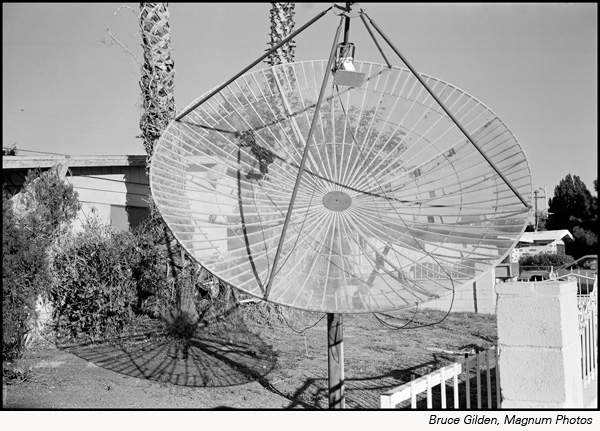
The entire interior of the storage unit was devoted to a video that presented audio interviews between Gilden and his subjects and still images or snippets of contact sheets. The video was projected onto a shower curtain, directing the audience's awareness to a curtained existence of the mortgage industry and the undulating nature of home for the subjects of Gilden’s photographs. Gilden’s voice booms throughout the storage unit in quickfire questioning of his subjects, rattling the tin walls and shaking the curtain.
Check out a excerpts from Gilden's video here, as well as a conversation between Gilden and John Shore, the Executive Director of the Community Housing Council of Fresno, California.
Perhaps the best surprise of Photoville was Conveyer Arts’ pop-up book store, a collaboration with Colpa Press of San Francisco. A miniature homage to Printed Matter’s yearly New York Art Book Fair at MoMA PS1, Conveyer offered a quiet tactibility less present in the immediacy of the plethora of documentary images. Conveyor offered hand-made letter press books, such as Luca Antonucci’s beautiful 10-off Fallen Empire, pristine attention to paper stock, and deskilled conceptual projects often printed on newsprint. The notable pop-up offered a cool breath--the reminder that the most profound impact a work of art might have, in a world laden with disposable imagery, is quiet and patient quality.
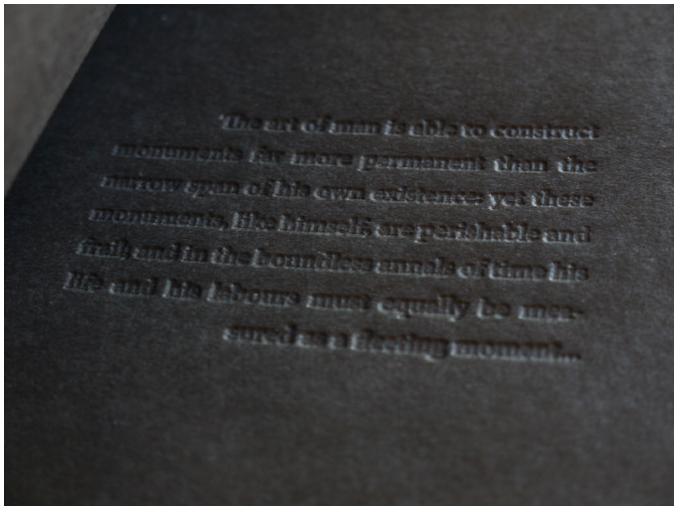
Copyright Luca Antonucci
Photo Awards Results
Posted by Daylight Books on
Our esteemed panel of judges is busy reviewing entries. Winners will be announced by months end. Stay tuned!